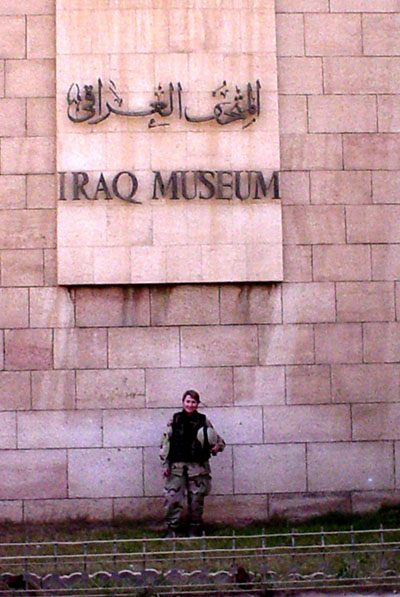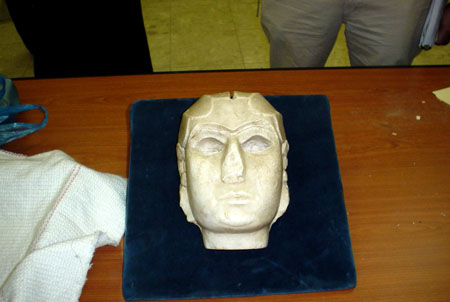Cori Wegener in front of the Iraq National Museum
 In May 2003, a curator at the Minneapolis Institute of the Arts (MIA) was sent into Baghdad by the U.S. Army – Cori Wegener, an ROTC commissioned officer in the Army Reserves was mobilized by the Civil Affairs Command to go to Iraq after the looting of the Iraq National Museum. “Civil Affairs is responsible in part for issues dealing with cultural property on the battlefield,” explains Wegener, who has since retired from the Reserves. “I was scheduled to go to Afghanistan with my Civil Affairs unit the summer of 2003.” Wegener received graduate degrees in political science and art history from the University of Kansas, and is curator of architecture, design, decorative arts, and sculpture at the MIA.
In May 2003, a curator at the Minneapolis Institute of the Arts (MIA) was sent into Baghdad by the U.S. Army – Cori Wegener, an ROTC commissioned officer in the Army Reserves was mobilized by the Civil Affairs Command to go to Iraq after the looting of the Iraq National Museum. “Civil Affairs is responsible in part for issues dealing with cultural property on the battlefield,” explains Wegener, who has since retired from the Reserves. “I was scheduled to go to Afghanistan with my Civil Affairs unit the summer of 2003.” Wegener received graduate degrees in political science and art history from the University of Kansas, and is curator of architecture, design, decorative arts, and sculpture at the MIA.
VW: Were you aware of the group of archaeologists and art curators led by McGuire Gibson (professor at the Oriental Institute at the University of Chicago and one of the world’s leading scholars on Mesopotamia) who went to the Defense Department in January 2003, and met with then Deputy Defense Secretary Paul Wolfowitz’s representative (Joseph Collins) to plead with them to ensure the safety of the cultural artifacts at stake? Please comment on their efforts, the response by DOD, and what played out upon the invasion. In your view, what went wrong?
CW: Yes, I read about this in the paper etc. before the invasion. Then I met Mac Gibson my first day at the museum. He had come into Iraq on a press pass! It is my view that we did not invade Iraq with enough troops to handle the stabilization of such a large country and population. Also, there was a distinct disconnect between what the military saw as their responsibility under international law (that the U.S. military avoid destruction of cultural, religious and historic sites unless there was a military necessity to do so) and the understanding of the cultural property community (Mac Gibson and others) about what they thought they heard the military planners (Joe Collins, et al) promise to do – actively post protection on those sites to prevent looting by the Iraqis. U.S. troops never received instructions to stop looting upon entry into Baghdad.
VW: What did you encounter when you entered the Iraq National Museum at the time of the invasion? Were there plans for better protection that just didn’t get carried out, or were sites such as this summarily dismissed by the war architects?
CW: To a certain extent they were dismissed in that the planners never truly seemed to believe the archaeologists and other Middle Eastern experts that the Iraqi people would almost certainly loot (this happened during the first Gulf War and was NOT a surprise to most people) and that the Iraqi Police were not up to the task of providing security (the CIA had told military planners that they were).
VW: Who was looting, and why? How much has been recovered?
CW: The looters were Iraqis, probably both pros and people with insider information who knew what they were looking for, and just opportunistic people from the neighborhood, etc. Contrary to the initial news reports, about 15,000 objects (not 170,000) were looted and about 5,000 have been recovered. The losses would have been far greater except that the museum staff hid nearly all the objects that were in the galleries in a secret storage location before the U. S. invasion, so the looters didn’t find them. The museum contains more than 500,000 objects total.
VW: Was there a particularly poignant example of damage that impacted you personally?
CW:The “Tel Harmal lion” was particularly sad because the looters smashed its head, presumably because they couldn’t get it off the base to steal it.
VW: While the fact of human suffering in war is far more important, can you speak to why it is so important to safeguard museums and art, specifically that found in what is now known as Iraq?
CW: This is the Fertile Crescent, ancient Mesopotamia, and the cradle of civilization! These objects don’t just represent the cultural heritage of the Iraqi people, but are the shared cultural heritage of all humankind.
VW:What are some NGOs working to protect archaeological sites of other areas impacted by armed conflict, and how can people here support their efforts?
CW: As you can imagine, the security situation in Iraq does not really allow any NGOs to work on the ground. Archaeological sites are protected by guards employed by the Iraqi Ministry of Culture, however there are not nearly enough to go around – less than 3,000 for more than 10,000 documented sites. There are a number of governments providing assistance such as money for weapons, vehicles, etc. but the looting is still a monumental problem and getting worse. The vast majority of sites are being looted on a daily basis. Once objects are removed from their archaeological context that information is lost forever.
In January of this year I founded an NGO – the U.S. Committee of the Blue Shield [www.americanblueshield.org]. The Blue Shield is the international symbol for protecting cultural property, much like the Red Cross is to humanitarian assistance. In this capacity I will attend a conference in August to address the issue of how to protect the archaeological sites in Iraq.
VW: Given the current state of affairs in Iraq, what do you find the spirit to be of the Iraqis working in the museum? How do they persevere, do you think?
CW: It’s a very difficult situation for the museum staff because the museum is still closed since the looting and has actually had many of the galleries and storage areas sealed off to deter future looters. The security situation is very bad I’m sure many are afraid to even come to work (this also happened in the weeks after the U.S. invasion). However, I know that everyone looks forward to a day when they can reopen the museum to the public and try to unite the Iraq people through their shared heritage.
VW: The 2005 revised edition of Marilyn Stokstad’s art history textbook includes the “Face of a woman” from Uruk c. 3300-3000 BCE and “Carved vase” (the so-called Uruk Vase), c. 3300-3000 BCE – and it’s noted that they had been “stolen and recovered in 2003.” Can you tell us the significance of the pieces, and do you know of the circumstances of the theft and recovery?
 CW: The Uruk (Warka) vase and the so called “Lady of Warka” are some of the most important archaeological objects in the world, hence their inclusion in most “Art History 101” textbooks. When I give my talks I often get an audible gasp from the audience when I say that the Face of a Woman (see photo) is the oldest naturalistic depiction of a woman’s face in the history of the world – and it was looted from the desk of the assistant director (who was never able to explain to my satisfaction why he had it there). However, it was recovered by the 812th Military Police and I’m delighted to have had the opportunity to hold it in my hands.
CW: The Uruk (Warka) vase and the so called “Lady of Warka” are some of the most important archaeological objects in the world, hence their inclusion in most “Art History 101” textbooks. When I give my talks I often get an audible gasp from the audience when I say that the Face of a Woman (see photo) is the oldest naturalistic depiction of a woman’s face in the history of the world – and it was looted from the desk of the assistant director (who was never able to explain to my satisfaction why he had it there). However, it was recovered by the 812th Military Police and I’m delighted to have had the opportunity to hold it in my hands.
The Uruk Vase was looted from the galleries because the staff felt it was too fragile to take off its modern base to hide with the rest of the collections – a calculated risk and they lost. However, it was returned by three young men in the trunk of their car under the “no questions asked” return policy. This was the first major object recovered.
VW: Will you be returning to Iraq, either in an official capacity, or out of personal desire?
CW: I retired from the Reserves in 2004 but I would very much like to return some day for the grand reopening of the museum.
VW: In tandem with your visit, the Shelburne Museum is offering free admission to the museum this season to Vermont National Guard personnel and their families. To those who might think of Iraq in nightmarish terms, why might it be a positive experience to contemplate the art and cultural artifacts of the region?
CW: I believe that art has a humanizing affect on people and that a people who have lost their cultural heritage have lost nearly everything. The Iraqi people are being torn apart by sectarian violence. Now more than ever, it’s important to preserve their shared cultural heritage. For Americans, military and civilian alike, it’s important to view Iraqi art and remember that because Iraq is the birthplace of civilization, we share that important cultural heritage and that heritage is worth saving.
Shelburne Museum presents “The Looting of the Iraq National Museum: A Curator’s Perspective” on Aug. 3, 7 p.m. Though free and open to the public, reservations are suggested for Ms. Wegener’s lecture and slide presentation: call (802) 985-3348 x3349. VT National Guard members interested in taking advantage of the Museum’s offer of free admission passes should contact the Guard’s State Family Program office.
